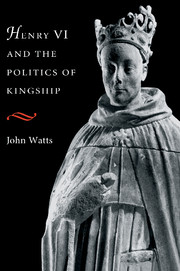Book contents
- Frontmatter
- Contents
- Preface
- List of abbreviations
- 1 Introduction: ideas and politics in fifteenth-century history
- 2 The conceptual framework
- 3 Government
- 4 Features of Henry VI's polity
- 5 The years of transition, 1435–1445
- 6 The rule of the court, 1445–1450
- 7 The search for authority, 1450–1461
- 8 Conclusion
- Bibliography
- Index
5 - The years of transition, 1435–1445
Published online by Cambridge University Press: 19 January 2010
- Frontmatter
- Contents
- Preface
- List of abbreviations
- 1 Introduction: ideas and politics in fifteenth-century history
- 2 The conceptual framework
- 3 Government
- 4 Features of Henry VI's polity
- 5 The years of transition, 1435–1445
- 6 The rule of the court, 1445–1450
- 7 The search for authority, 1450–1461
- 8 Conclusion
- Bibliography
- Index
Summary
The ten-year period from 1435 to 1445 saw the establishment of what has been called the ‘personal rule’ of Henry VI. It began with the first successful moves to shift the exercise of power towards the youthful monarch himself, and ended in his marriage, arguably the most meaningful signal to political society that the minority and the forms of government associated with it were at an end. In most of the literature on this period, the story of these years is a fairly simple one. The minority comes to an end between 1435 and 1437, and the king, now effectively an adult, proceeds to rule in a more-or-less normal way until he falls under the influence of Suffolk and his faction round about the mid-1440s. To a large extent, the pace of change in the 1430s is set by Henry himself: already conscious of his high estate in 1432, he strains on the leash of conciliar power in 1434 and begins to assert control over royal patronage in 1436. In November 1437, a council is appointed to rule with the king along broadly traditional lines. Its demise, between about 1444 and 1447, is treated as one of the main indications and, indeed, features of the curial takeover which was to play such an important part in causing the crisis of 1450.
In this chapter and the next, I shall be arguing for an alternative version of events. There seems to me to be little evidence that Henry himself was the author of his slow and halting progression to something resembling full authority: indeed, the fact that it was so slow and, in certain ways, incomplete tends to suggest the opposite.
- Type
- Chapter
- Information
- Henry VI and the Politics of Kingship , pp. 123 - 204Publisher: Cambridge University PressPrint publication year: 1996



